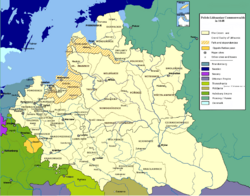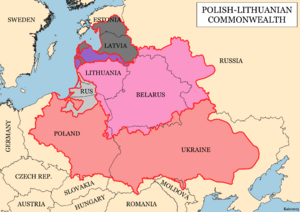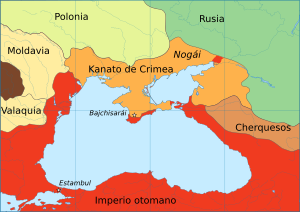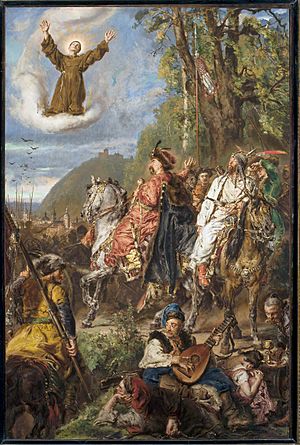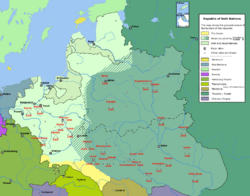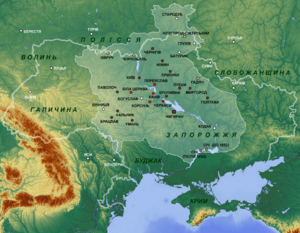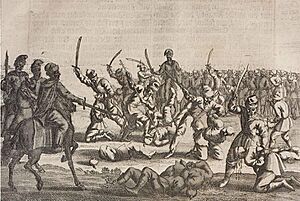Khmelnytsky Uprising facts for kids
Quick facts for kids Khmelnytsky Uprising |
|||||||||
|---|---|---|---|---|---|---|---|---|---|
| Part of the Deluge | |||||||||
 Entrance of Bohdan Khmelnytsky to Kyiv, Mykola Ivasyuk |
|||||||||
|
|||||||||
| Belligerents | |||||||||
| Commanders and leaders | |||||||||
(till 1657) |
|||||||||
The Khmelnytsky Uprising was a major rebellion that happened between 1648 and 1657. It took place in the eastern parts of the Polish–Lithuanian Commonwealth. This uprising led to the creation of a Cossack Hetmanate in Ukraine.
The rebellion was led by hetman Bohdan Khmelnytsky. His Zaporozhian Cossacks teamed up with the Crimean Tatars and local Ukrainian farmers. They fought against the rule of the Polish–Lithuanian Commonwealth. The uprising caused a lot of suffering for people, especially for Catholic and Uniate clergy, and Jewish communities. There were also harsh responses from the Commonwealth's forces.
This uprising is very important in the history of Ukraine's relationship with Poland and Russia. It ended the control of Polish Catholic nobles (called szlachta) over the Ukrainian Orthodox people. It also led to eastern Ukraine becoming part of the Tsardom of Russia after the Pereiaslav Agreement in 1654. In this agreement, the Cossacks promised loyalty to the tsar but kept a lot of freedom.
The uprising also started a difficult time in the Hetmanate known as the Ruin. The success of this rebellion against Poland, along with other wars Poland fought with Russia and Sweden, marked the end of Poland's "Golden Age." This period of decline is known in Polish history as "the Deluge."
Contents
Why the Uprising Started
In 1569, the Union of Lublin joined several southern regions of the Grand Duchy of Lithuania with the Crown of Poland. These regions included Volhynia, Podolia, Bracław, and Kiev. This agreement created the new Polish–Lithuanian Commonwealth (Rzeczpospolita).
Even though local nobles were given full rights, their adoption of Polish culture made them different from the common people. Powerful families, like the Wiśniowiecki and Ostrogski, gained even more land and power. These powerful nobles, called magnates, often treated the lower-class Ruthenians harshly. They also introduced Catholic practices and used Jewish managers (called arendators) to run their large estates.
The Orthodox traditions were also affected. The growing Russian state wanted to control the southern lands of Kievan Rus'. After the fall of Constantinople, Russia claimed that the leader of the Russian Orthodox Church was now the most important.
The push for Catholic expansion led to the Union of Brest in 1596. This union tried to keep the Eastern Orthodox churches in Ukraine, Poland, and Belarus independent by linking them with the Bishop of Rome. Many Cossacks were against this new church. While not everyone joined one church, the idea of freedom became very strong during Bohdan Khmelnytsky's military actions.
Bohdan Khmelnytsky's Story
Bohdan Khmelnytsky came from a noble family and went to a Jesuit school. When he was 22, he joined his father in serving the Commonwealth, fighting against the Ottoman Empire. After being held captive, he returned home as a Registered Cossack. He lived on his farm, called a khutor, in Subotiv with his family.
Khmelnytsky was well-respected among the Cossacks. He fought in campaigns and even met King Władysław IV Vasa in Warsaw. However, his life changed when Aleksander Koniecpolski, a powerful magnate's son, tried to take Khmelnytsky's land. In 1647, a local official named Daniel Czapliński harassed Khmelnytsky on behalf of Koniecpolski. They raided Khmelnytsky's farm twice, causing damage and beating his son. Khmelnytsky moved his family to a relative's house.
He tried to get help from the king in Warsaw, but the king either couldn't or wouldn't stand up to the powerful magnate. Since Polish officials didn't help him, Khmelnytsky turned to his Cossack friends. The unfair treatment of a Cossack gained a lot of support among other Cossacks. Throughout 1647, Khmelnytsky traveled and talked with Cossack leaders.
Polish authorities became suspicious and arrested him. But a colonel named Mykhailo Krychevsky helped Khmelnytsky escape. With his supporters, Khmelnytsky headed for the Zaporozhian Sich, a Cossack stronghold.
The Cossacks were already ready for a new rebellion. The Polish king had planned a war with the Ottoman Empire, which the Cossacks liked because it meant they could raid Ottoman lands. But the Polish parliament (Sejm) canceled the war. This made the Cossacks very angry, as they were used to profitable raids.
Khmelnytsky learned from past Cossack rebellions. He knew that Cossack foot soldiers were excellent, but they couldn't beat the Polish cavalry, which was very strong. He realized that if Cossack infantry teamed up with Crimean Tatar cavalry, they could create a balanced force and have a chance to defeat the Polish army.
The Uprising Begins
On January 25, 1648, Khmelnytsky arrived at the Zaporizhian Sich with 400–500 Cossacks. They quickly took control of the entrance. Once inside, Khmelnytsky's speeches and diplomacy inspired the oppressed Ruthenians. As his men fought off Commonwealth forces, more people joined his cause. By the end of the month, the Cossack council (Rada) elected him Hetman.
Khmelnytsky focused on getting more fighters. He sent messengers to Crimea, asking the Tatars to join him against their common enemy, the Commonwealth.
By April 1648, news of the uprising had spread. The Commonwealth's military leaders, Mikołaj Potocki and Marcin Kalinowski, sent 3,000 soldiers under Potocki's son, Stefan. They didn't wait for more troops from Prince Jeremi Wiśniowiecki. Khmelnytsky gathered his forces and met them at the Battle of Zhovti Vody. Many Registered Cossacks switched sides from the Commonwealth to Khmelnytsky during this battle.
This victory was quickly followed by another at the Battle of Korsuń. Both the elder Potocki and Kalinowski were captured by the Tatars.
The Polish state lost many soldiers and leaders. King Władysław IV Vasa also died in 1648, leaving Poland without a leader during the rebellion. Polish nobles were fleeing their burning palaces and estates. Meanwhile, Khmelnytsky's army marched west.
Khmelnytsky stopped his forces at Bila Tserkva. He sent a list of demands to the Polish Crown. These included increasing the number of Registered Cossacks, returning churches to the Orthodox faith, and paying Cossacks their wages, which had been held back for five years.
News of peasant uprisings worried Khmelnytsky at first. But after talking with his advisors, the Cossack leaders realized they could gain independence. Khmelnytsky's personal anger towards the nobles helped turn the uprising into a national movement. Khmelnytsky's forces joined a peasant revolt at the Battle of Pyliavtsi, dealing another big blow to the weakened Polish army.
Khmelnytsky was convinced not to attack Lviv, supposedly for a large payment. After getting the money, he moved to attack Zamość. Then he heard that a new Polish King, John Casimir II, had been elected. Khmelnytsky liked this king. The king sent him a letter, promising privileges for Cossacks and Orthodox people. He asked Khmelnytsky to stop fighting and wait for a royal group. Khmelnytsky agreed and turned back.
He made a grand entry into Kiev on Christmas Day in 1648. People cheered him as "the Moses, savior, redeemer, and liberator of the people from Polish captivity... the illustrious ruler of Rus."
In February 1649, Khmelnytsky met with a Polish group in Pereiaslav. He declared that he was "the sole ruler of Rus" and had "enough power in Ukraine, Podolia, and Volhynia... in his land and principality stretching as far as Lviv, Chełm, and Halych". It became clear that Khmelnytsky saw himself as the leader of an independent state.
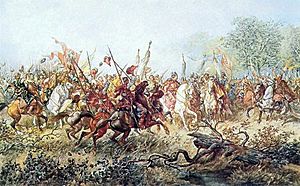
A text from Vilnius in 1650–1651 honored Khmelnytsky, saying: "While in Poland it is King Jan II Casimir Vasa, in Rus it is Hetman Bohdan Khmelnytsky".
After the Battles of Zbarazh and Zboriv, Khmelnytsky gained many benefits for the Cossacks through the Treaty of Zboriv. However, when fighting started again, his forces suffered a huge defeat in 1651 at the Battle of Berestechko. This was one of the biggest land battles of the 17th century. His allies, the Crimean Tatars, abandoned them. The Cossacks were forced to accept the Treaty of Bila Tserkva at Bila Tserkva.
A year later, in 1652, the Cossacks got their revenge at the Battle of Batih. Khmelnytsky ordered Cossacks to kill all Polish prisoners and paid the Tatars for them. This event is known as the Batih massacre.
However, the huge losses at Berestechko made it hard to create an independent state. Khmelnytsky had to choose between staying under Polish–Lithuanian influence or allying with the Muscovites (Russians).
The Tatars' Role
The Tatars from the Crimean Khanate were a state under the Ottoman Empire. They joined the uprising because they saw it as a way to capture people to sell as slaves. During the Uprising, many captives were sent to slave markets in Crimea. Jewish communities in the Ottoman Empire even collected money to try and free their people.
What Happened Next
Within a few months, most Polish nobles, officials, and priests were gone from the lands that are now Ukraine. The Commonwealth lost over a million people during the uprising. Jewish communities also suffered greatly because they were often managers for the nobles.
The uprising started a period in Polish history called The Deluge. This time included a Swedish invasion of the Commonwealth. The uprising temporarily freed Ukrainians from Polish rule. But soon after, they came under Russian rule.
Weakened by wars, Khmelnytsky convinced the Cossacks to ally with the Russian tsar in the Treaty of Pereyaslav in 1654. This led to the Russo-Polish War (1654–1667). When Poland–Lithuania and Russia signed a truce in 1657, Khmelnytsky's Cossacks supported Sweden's allies in invading the Commonwealth.
Even though the Commonwealth tried to regain control over the Cossacks (like with the Treaty of Hadiach in 1658), the Cossacks became more and more influenced by Russia. The Hetmanate entered a new political situation, very different from the Commonwealth. The church there became much more controlled by the tsar. Russia had a history of imprisoning or executing Orthodox officials, which was new to people from the Commonwealth.
As the Commonwealth grew weaker, Cossacks became more integrated into the Russian Empire. Their freedom and special rights slowly disappeared. These rights were mostly gone after the Great Northern War (1700–1721), when hetman Ivan Mazepa sided with Sweden. By 1795, when Poland was no longer an independent country, many Cossacks had already left Ukraine to settle in the Kuban region and became more like Russians.
Historians have different ideas about when the uprising ended. Russian and some Polish sources say it ended in 1654 with the Treaty of Pereyaslav. Ukrainian sources say it ended with Khmelnytsky's death in 1657. A few Polish sources say 1655. There was some overlap between the end of the uprising and the start of the Russo-Polish War (1654–1667), as Cossack and Russian forces became allies.
Impact of the Uprising
Estimates of how many people died during the Khmelnytsky uprising vary. As historians find better information, these numbers are often updated. The total population loss for the entire Commonwealth between 1648 and 1667 (which includes the Uprising, the Polish-Russian War, and the Swedish invasion) is estimated at 4 million people. This means the population dropped from about 11–12 million to 7–8 million.
Suffering and Violence
Before the Khmelnytsky uprising, powerful nobles often rented out their lands and privileges to managers, many of whom were Jewish. These managers collected money for the nobles and kept a percentage. Because the nobles didn't manage their estates directly, the managers became targets of anger for the struggling peasants. Khmelnytsky told the people that the Poles had "sold them as slaves into the hands of the accursed Jews."
With this message, Cossacks and peasants attacked many Jewish and Polish townsfolk, as well as Polish nobles (szlachta), in 1648–1649. A historical account from that time, Yeven Mezulah, describes the widespread violence. It states that wherever Cossacks found nobles, royal officials, or Jews, they attacked them. They also looted Jewish and noble estates and burned churches.
Most Jewish communities in the rebellious Cossack Hetmanate were severely affected. However, some Jewish populations were spared, like in the town of Brody. Brody was a major trading center, and its Jewish residents were considered useful for trade. They were only required to pay "moderate payments" in goods.
One estimate from 1996 suggests that 15,000–30,000 Jews were killed or taken captive, and 300 Jewish communities were completely destroyed. A 2014 estimate puts the number of Jews who died between 1648–1649 at 18,000–20,000. Of these, 3,000–6,000 Jews were killed by Cossacks in Nemirov in May 1648, and 1,500 in Tulczyn in July 1648.
While some older sources suggest 100,000 or more Jews were killed, more recent studies suggest lower numbers, between 40,000 and 100,000, or even lower.
In Jewish history, these events are known as Gzeyres Takh Vetat, or Takh Vetat. This means "the (evil) decrees of (years) 408 and 409," referring to the Jewish calendar years 5408 and 5409 (1648 and 1649 in the non-Jewish calendar).
Impact on Ukrainians
While Cossacks and peasants often attacked Polish nobles and their helpers, they also suffered terribly. They faced harsh responses from the Poles, raids by Tatars, famine, disease, and general destruction from the war.
At the start of the uprising, the army of the magnate Jeremi Wiśniowiecki caused great destruction as they retreated. They left behind many burned towns and villages. Also, Khmelnytsky's Tatar allies often continued their raids against civilians, even when the Cossacks protested. After the Cossacks allied with the Tsardom of Russia, the Tatar raids became even more widespread. This, along with famine, led to many areas of the country becoming almost empty of people.
From Autumn 1654 to Spring 1655, during the "Bracław Campaign," Stefan Czarniecki's army, with help from Crimean Tatars, caused immense suffering to the Ukrainian population. Some sources estimate 100,000 Ukrainians died, while others suggest up to 300,000.
More to Explore
- History of the Polish–Lithuanian Commonwealth (1569–1648)#Cossacks and Cossack rebellions
- Ogniem i Mieczem
- Wars of national liberation
- Russo-Polish War (1654–1667)
- Deluge (history)
- With Fire and Sword (film)
- Pereiaslav Agreement


